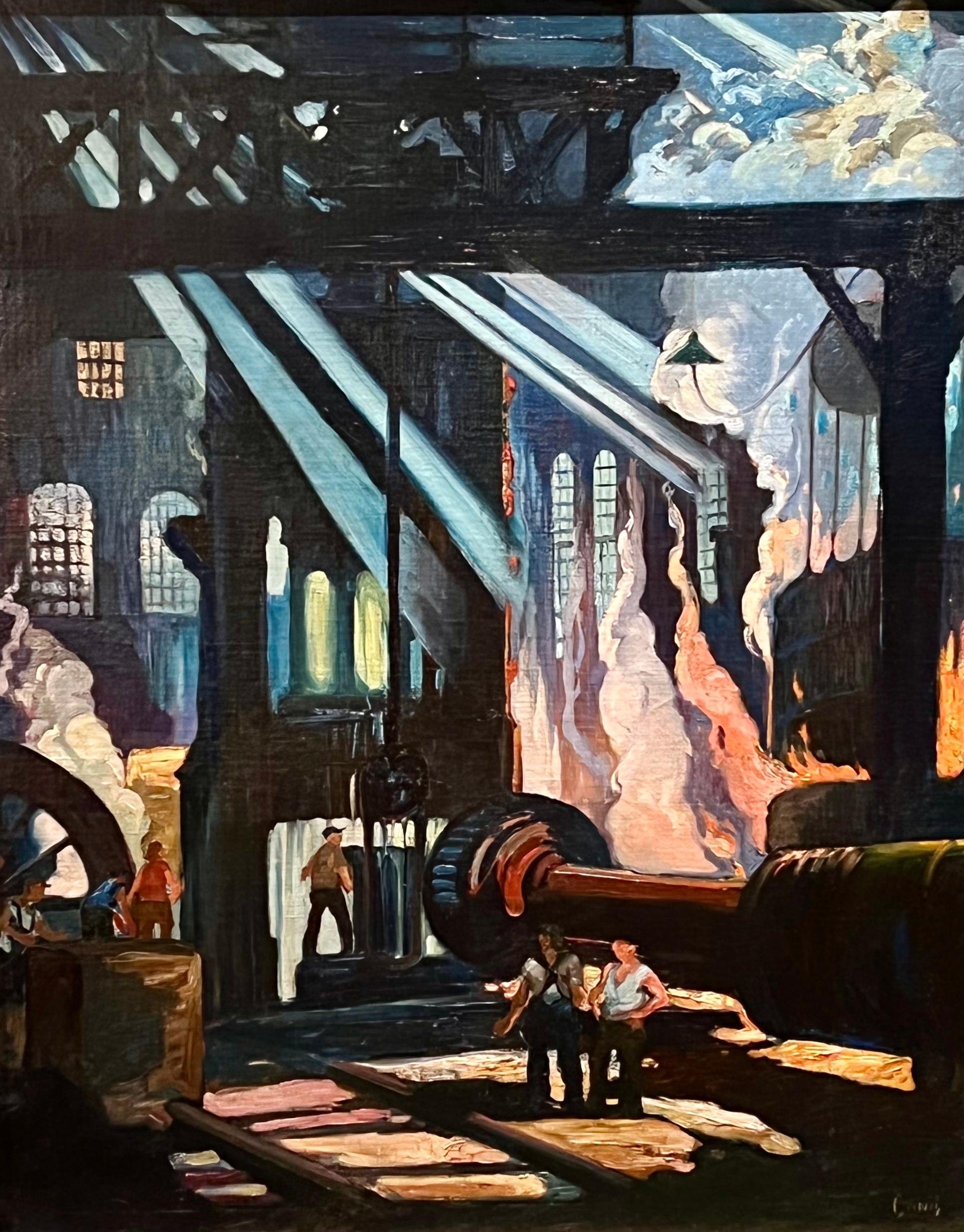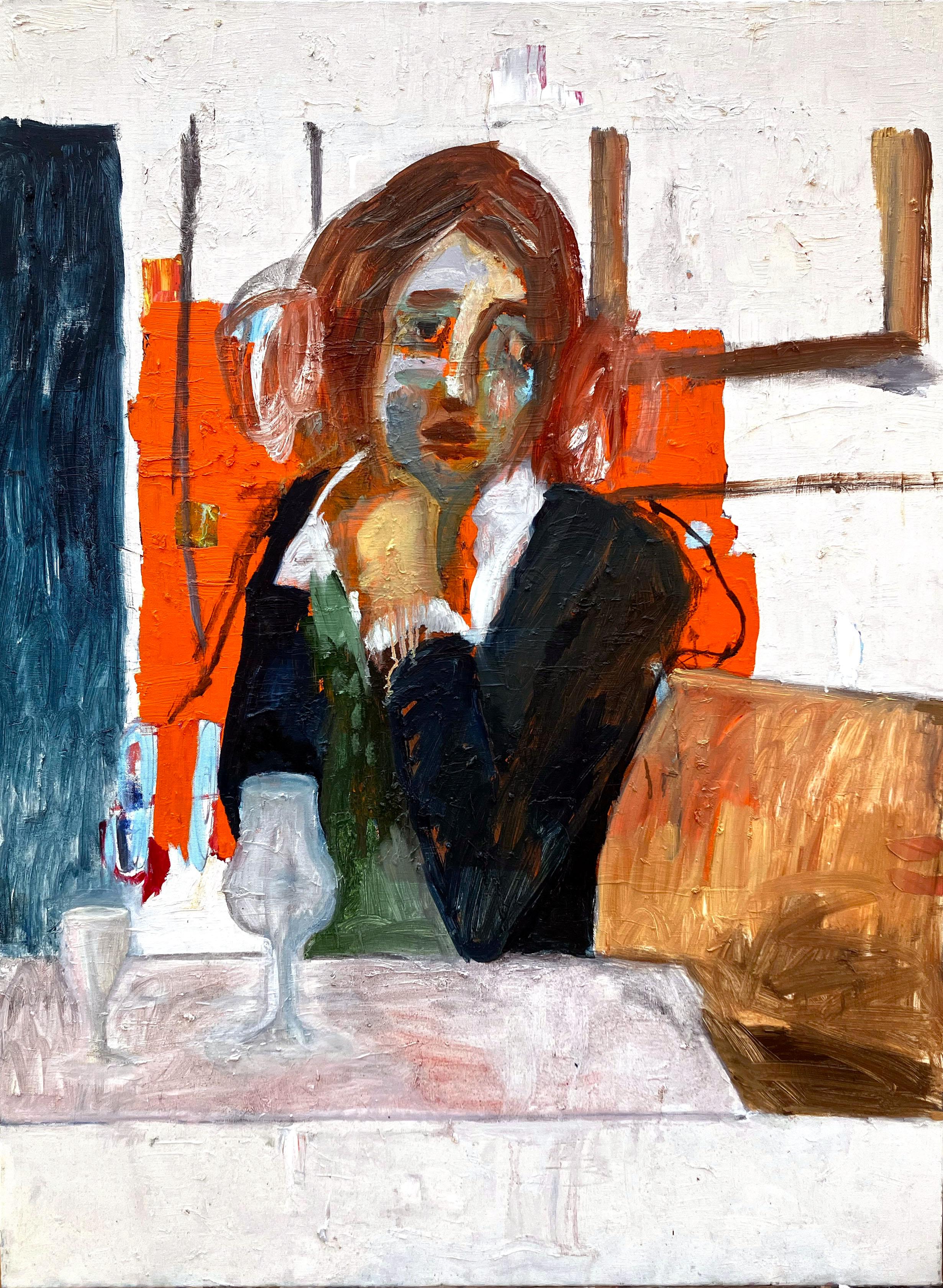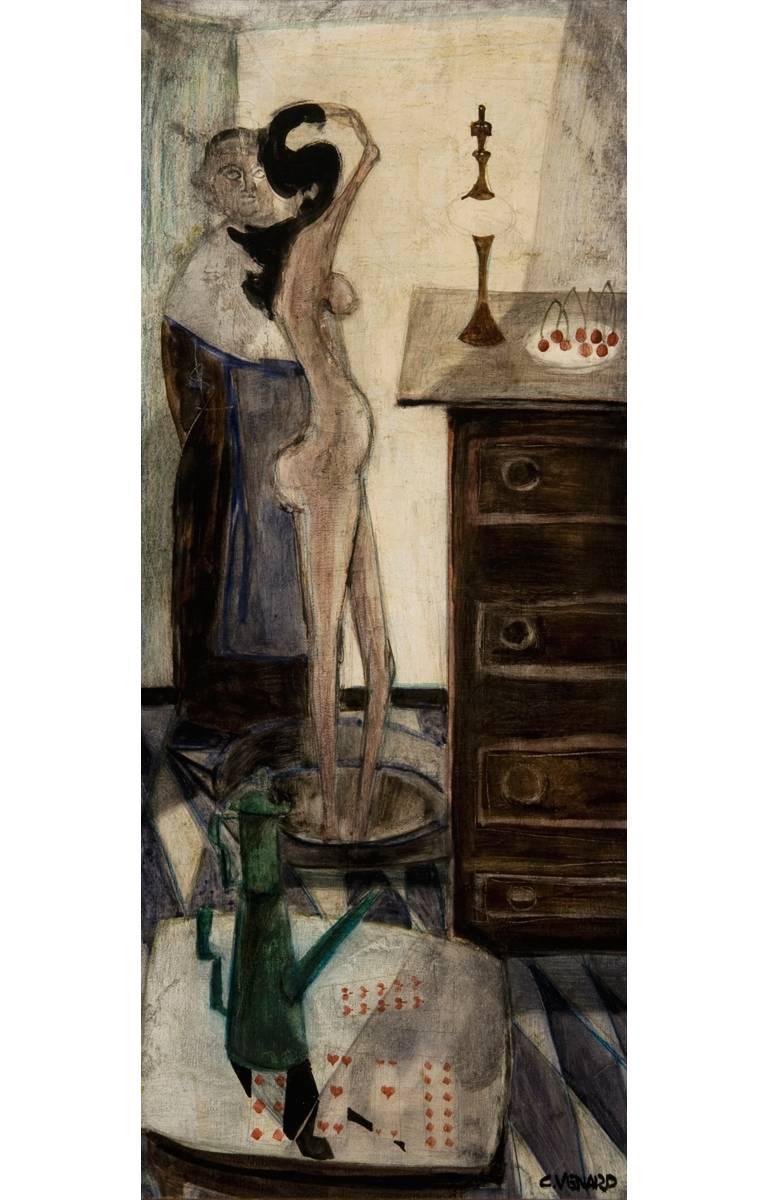Items Similar to Large French/ Polish Modernist Oil Painting Interior Room Figures Reading & Dog
Want more images or videos?
Request additional images or videos from the seller
1 of 12
Jacob MarkielLarge French/ Polish Modernist Oil Painting Interior Room Figures Reading & Dog
About the Item
Interior Scene
by Jacob Markiel (Polish 1911-2008) *See notes below
oil on canvas, unframed
canvas: 34 x 30 inches
provenance: the artists estate, south of France
condition: very good and sound condition
Jacob Markiel was born into a humble family in Lodz and started to work at a very young age. One day, his father caught him drawing, tore up his drawings and forbid him from painting. His mother intervened and signed him up to attend Isaac Brauner’s drawing course. This decisive meeting left a mark on his childhood. When he was sixteen years old, the artist Marek Szwarc recommended him to the Polish art critic Dr Willem Fallek. He studied at the School of Fine Arts in Krakow and was awarded a scholarship. He arrived in Paris in 1933 and lived in the Belleville district. Sculptor Naoum Aronson welcomed him and introduced him to the Baron de Rothschild. A few years later, he was awarded the third prize at the Ecole des Beaux-Arts in Paris. He studied at painter Jean Souverbie’s studio. Markiel’s conception of art was very classical.
In 1939, Markiel enlisted in the French army. The next year, he was arrested and spent three years at a prison at Montluc and in the Compiegne camp. In 1943, he was freed for health reasons and decided to go to Africa. He was arrested by the Nazis the day before his departure and was interned in Drancy. He was deported to Auschwitz on June 23, 1943 on convoy number 55. After the war, he returned to France and was welcomed by Isaac Dobrinsky. He devoted himself from then on to painting, thanks to the support of his wife Esther.
- Creator:Jacob Markiel (1911 - 2008, Polish)
- Dimensions:Height: 34 in (86.36 cm)Width: 30 in (76.2 cm)
- Medium:
- Movement & Style:
- Period:
- Condition:
- Gallery Location:Cirencester, GB
- Reference Number:1stDibs: LU509313290552

About the Seller
5.0
Platinum Seller
These expertly vetted sellers are 1stDibs' most experienced sellers and are rated highest by our customers.
Established in 1989
1stDibs seller since 2016
3,443 sales on 1stDibs
Typical response time: 2 hours
- ShippingRetrieving quote...Ships From: Cirencester, United Kingdom
- Return PolicyA return for this item may be initiated within 3 days of delivery.
More From This SellerView All
- 20th Century German Modernist Oil Painting Pianist in Concert Hall with AudienceLocated in Cirencester, GloucestershireArtist: Elisabeth Hahn (German 1924-2021) Elisabeth Hahn was born in Dortmund, Germany, where she began her artistic studies. In 1953, she moved to Paris. She continued her studies ...Category
20th Century Modern Figurative Paintings
MaterialsOil, Canvas
- Fine 1950's English Oil Grand Interior Room Scene Ancestral Portraits signedLocated in Cirencester, GloucestershireThe Guildhall, Worcester English School, mid 20th century indistinctly signed verso oil on canvas canvas: 20 x 24 inches provenance: private collection, UK condition: very good and sound condition The Worcester Guildhall was originally built as a meeting place for Worcester merchants around 1227. As with many other guildhalls, it became the centre for civic administration, a role it maintained after the merchant guild had disappeared. The present Worcester Guildhall is a superb Queen Anne building, begun in 1722 by Thomas White, a pupil of Sir Christopher Wren. White was badly paid for his efforts, and he died in poverty in 1738, bestowing the money he was owed on the Worcester Royal Infirmary. The city finally paid its debt in 1753. The exterior of the Guildhall is brick, dressed with stone. White himself is said to have carved the figure of Queen Anne over the entry, as well as those of Charles I and II, a reminder of the city's long history of royal support. The interior is superb, boasting exceptional period decoration. The Tourist Information Centre is now located in the Guildhall. HISTORY In 1227 Henry III granted the citizens of Worcester a royal charter granting them the right to establish a guild of merchants. The guild was responsible for controlling trade in the city, but their meeting place gradually became the main centre of administration for city government and acted as a courthouse. So, in effect, the Guildhall was the town hall, and though the city guilds have long since vanished, the Guildhall name lives on. The medieval guild merchants would not recognise the building that faces onto High Street now. Their guildhall was a large timber-framed building, occupying the same site, with a piazza for shops fronting the street, courts of justice at each end, and a prison to the north of the building. Part of the prison was a cell called 'the peephole', which gained a notorious reputation. There was a gaoler's house, and attached to it an alehouse from which the gaoler sold ale at extremely high prices to any prisoner who could afford the cost. In 1717 the city administration decided on a new Guildhall, and they knew just who to call; upon to build it. Thomas White was not an architect in the way we think of it today, but a stonemason. In 1705 he had carved a statue of Queen Anne to stand in front of the medieval Guildhall and was made a Freeman of the City. The total cost of the fashionable new red-brick building was £3727. The Corporation only put forward £800, and the rest had to be raised by public subscription. The centre section of the new Guildhall was finished by 1724 and has remained almost unchanged since then. The central facade is a wonderful example of early Georgian style, with three bays flanked by Corinthian pillars. Over the entrance is a huge carving incorporating the Hanoverian royal arms. White's earlier statue of Queen Anne was placed in a niche over the door, and on either side were statues of Charles I, depicted holding a church, and Charles II, with an orb and royal sceptre. On the rooftop are figures of Labour, Peace, Justice, Plenty, and Chastisement. North and south wings were added within a few years of the central block. The south wing was used as a judge's lodging when the assizes were taking place, but throughout the rest of the year it housed a coffee shop. The most striking external feature of the Guildhall is a set of iron gates...Category
Mid-20th Century Modern Interior Paintings
MaterialsCanvas, Oil
- Large 1970's French Modernist Oil Painting The Card Game Players Casino InteriorLocated in Cirencester, GloucestershireThe Card Game in the Casino French Modernist, circa 1970's oil on canvas, unframed canvas: 21.5 x 25.5 inches provenance: private collection, France condition: very good and sound co...Category
Mid-20th Century Modern Figurative Paintings
MaterialsCanvas, Oil
- Mid 20th Century French Modernist Signed Oil Painting Lady Reclining on SofaLocated in Cirencester, GloucestershireThe Reclining Model French School, mid 20th century signed Labat oil on canvas, unframed board: 18 x 24 inches provenance: private collection, France condition: very good and sound c...Category
Mid-20th Century Modern Figurative Paintings
MaterialsCanvas, Oil
- Fine 19th Century Interior Scene Baronial Hallway Children Playing on StaircaseBy Victorian SchoolLocated in Cirencester, GloucestershireThe Country House Interior British School, 19th century oil painting on canvas, framed canvas: 21 x 17 inches framed: 24 x 20 inches conditon: very sound, presentable and good. Frame...Category
19th Century Victorian Interior Paintings
MaterialsOil, Canvas
- 1960's French Interior Scene Lady Reflection in Window Sewing Still Life FlowersLocated in Cirencester, GloucestershireInterior by Josine Vignon (French 1922-2022) stamped verso oil painting on canvas, unframed canvas: 24 x 29 inches very good condition provenance: from the artists estate, France J...Category
Mid-20th Century Post-Impressionist Interior Paintings
MaterialsCanvas, Oil
You May Also Like
- Industrial Mid-20th Century WPA Modern Men Working American Scene Social RealismLocated in New York, NYIndustrial Mid-20th Century WPA Modern Men Working American Scene Social Realism George Pearse Ennis (American, 1884-1936) "Forging a Gun Tube #1...Category
1910s American Modern Interior Paintings
MaterialsCanvas, Oil
- Do You Mind If I Hum While You Talk, abstracted woman in bar w brushworkBy C. DimitriLocated in Brooklyn, NYFin de Siecle, Nabis-styled woman in cafe. Abstract Expressionism looms behind her. Tribute to the fearless and incandescent painting of Édouard Vuillard.Category
2010s Modern Interior Paintings
MaterialsCanvas, Oil
- Mid Century Interior Scene Animals Figures Rare Cityscape Oil Painting 1963Located in Buffalo, NYA fantastic MidCentury interior scene painted in 1963 and signed illegibly. This work comes in a contemporary wood frame.Category
1960s Modern Interior Paintings
MaterialsCanvas, Oil
- William Fisher Classic American Illustration on CanvasLocated in Larchmont, NYWilliam Fisher (American, 1891-1985) Untitled, 20th Century Oil on canvas/illustration 23 3/4 x 29 3/4 in. Framed: 31 x 37 1/4 x 1 in. Signed lower right: William Fisher William Fis...Category
20th Century American Modern Figurative Paintings
MaterialsCanvas, Oil
- Radha Krishna, Mythology, Oil on Canvas, Blue, Grey by Indian Artist "In Stock"By Wasim KapoorLocated in Kolkata, West BengalWasim Kapoor - Untitled - 42 x 42 inches ( unframed size ) Oil on Canvas. This work will be despatched in a roll form or framed as per the need of the buyer An estimate to ship fra...Category
2010s Modern Figurative Paintings
MaterialsCanvas, Oil
- Nu au TubBy Claude VenardLocated in Dallas, TXSigned "C. VENARD" at lower right Overall dimensions, including the frame, are 33 3/4 x 18 1/4 inchesCategory
Mid-20th Century Modern Interior Paintings
MaterialsCanvas, Oil
Recently Viewed
View AllMore Ways To Browse
Friedrich Konig
Loose Pastel Blue Prize
Alessandro Sani
Ayandare Adeniran Ayanmuyiwa
Bernard Leech
Thomas Vila
Olalekan Adeyemi
Picasso Minotauro
Paintings Of La Rochelle France
Trap Box
Art Auctions San Francisco Calif
Sagittarius Daily
Lincoln Motor
Norman Davies
Le Moyne
Morgan Horse Club
Hollywood Lake
Julie Speed





